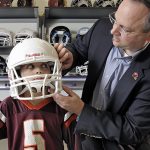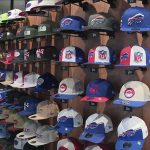Who is winning on the footwear price point battleground? It depends which price point you pick, according to data gathered for “The Sporting Goods Market in 2005” report to be published by the National Sporting Goods Association (NSGA) in spring of this year.
Over the past five years, sporting goods stores have increased their unit sales of athletic footwear in the $20-$39 (up from 33.1% to 34.3%) and $40-$59 (up from 28.3% to 32.6%) price points. However, their sales have slipped in the $60-plus price point, from 34.3% to 28.6%.
Over the same five years, specialty athletic footwear stores have increased their unit sales in the $60-plus price point, from 46.8% to 48.6%. Their sales have declined modestly in the $20-$39 (down from 19.6% to 19.1%) and $40-$59 (down from 31.5% to 30.9%) price points.
In their strongest price points ($20-$39 and $40-$59), sporting goods stores face growing competition from other channels of distribution.
“In the $20-$39 price point, discount stores (up from 30.0% to 33.4%), department stores (up from 34.6% to 39.1%) and family footwear stores (up from 27.1% to 34.3%) offer the greatest challenge,” said NSGA Vice President of Information & Research Thomas B. Doyle. “In the $40-$59 price point, the challenges come from department stores (up from 37.6% to 38.5%) and family footwear stores (up from 22.6% to 27.5%).
“In their strongest price point ($60-plus), specialty athletic footwear stores are not seeing any growing competition from other channels of distribution,” Doyle said. “However, Internet sales, which have tripled in five years, get 40% of their sales at this price point. Internet sales represent slightly less than 3% of all athletic footwear sales.”
Overall, he average price of athletic footwear rose 1.1% to $39.32 in 2004 from $38.88 in 2003. In sporting goods stores, the average price rose 1.4% to $47.02 and 2.1% in specialty athletic footwear stores, to $59.02. Family footwear stores showed the strongest gain, up 10.6% to $37.16—a $3.47 rise from 2003.
Based on a consumer study of 100,000 U.S. households, “The Sporting Goods Market in 2005” report summarizes 2004 retail sales totals-in units and dollars-for 22 types of athletic and sports shoes as well as products in more than 20 sport categories.
Also featured are purchaser demographics-annual family income, age and gender of product user, education of household head and sales according to region of the country. Place-of-purchase data allow for analysis of the industrys channels of distribution. Consumer purchases on the Internet are reported.
The report, which NSGA has published for almost two decades, provides selected product sales history for the last 10 years. This allows the analysis of long-term trends. Brand share reports on individual shoe categories are available separately.
The 78-page report is prepared for NSGA by Irwin Broh & Associates, a research company nationally recognized for its work in the sports and leisure field. Cost of the report to NSGA members is $225, to non-members, $325. Pre-publication discounts are now available. Sustaining NSGA retailer/dealer members and manufacturer members receive the report free. For additional information, contact NSGA, 1601 Feehanville Drive, Suite 300, Mount Prospect, Ill. 60056-6035. Phone: (847) 296-6742; fax: (847) 391-9827; or visit the NSGA website, www.nsga.org.
Founded in 1929, NSGAs mission is to help all members profit in a competitive marketplace. The Association organizes and hosts the annual NSGA Management Conference & Team Dealer Summit, the sporting goods industrys premier educational and networking event (Next: May 22-25, 2005, at the JW Marriott Starr Pass Resort & Spa, Tucson, Ariz.).
For more information on NSGA member services, visit the Association home page (www.nsga.org); call Rhonda Onuszko at NSGA, (847) 296-6742, Ext. 130; e-mail: ronuszko@nsga.org; or fax (847) 391-9827.









